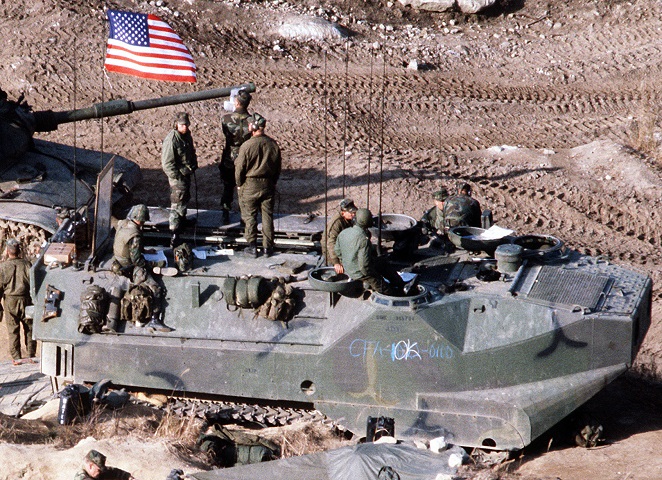
Landing Vehicle, Tracked, Command, Mark 7 in South Korea.

This is a later-production LVTC7 since the vehicle commander's weapon station has been replaced by an unarmed vision cupola. The array of radio antennas immediately indicate that this is a command vehicle. The engine air inlet grille is on top of the vehicle's bow, and just behind this, beside the driver's cupola, is the ventilator-aspirator valve. The starboard water jet deflector is visible above the rear of the track. Behind the LVTC7 is an M60A1 tank. (Picture taken 29 Oct 1983 by CPL T. S. Quade; available from the Defense Visual Information Center.)

The commander's cupola on this machine has been armed with a 7.62mm M60 machine gun. (Picture taken 1 Sep 1982 by PH2 Mark Dietrich; available from the National Archives.)

The vehicle nearest the camera in this shot is also a later-production LVTC7. The commander's cupola is armed with an M60 machine gun like the vehicle above. The tall, U-shaped post on the side of the vehicle is a rest for the right roof cargo hatch. The driver's cupola is open on the vehicle's left side, and just behind this is the cupola for the unit commander. The unit commander also had a position, along with three other marines, at the staff desk situated in the right side passenger compartment. The left side of the passenger compartment was occupied by the communications module. The vehicle on front of the LVTC7 is an LVTR7. (Picture taken 26 Feb 1984 by PHC Chet King; available from the Defense Visual Information Center.)

The interior is the subject of this picture, showing the desks, radio racks, and seating for the command staff. (Picture from FMFM 9-2 Amphibious Vehicles.)

Though the exact organization was determined by the supported unit commander based on the mission, concept of operations, available assets, enemy situation, and nature and area of operation, the above is a typical organization for command of a battalion-sized mechanized combined arms task force while on the move. An escort AAVP7 accompanied each AAVC7 to provide protection, fire support, and additional staff and maintenance personnel. (Picture from FMFM 9-2 Amphibious Vehicles.)